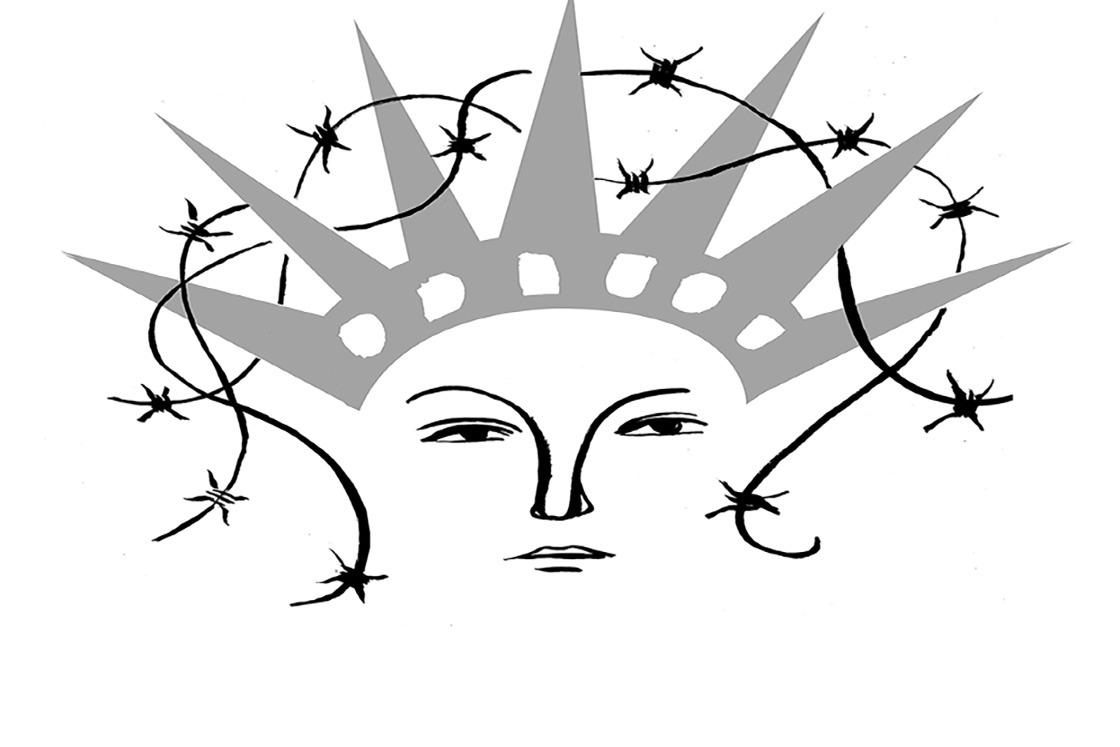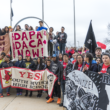I recently went to Ellis Island on a beautiful spring morning and spent a couple of hours by myself watching the light pour into the Great Hall before the museum opened to the public. I was there to arrange the most recent iteration of an art project I’ve been working on for several years, this one having to do with a historic event that happened at Ellis Island back in 1942 and a related incident in 1998. To be there all these years later, knowing what I know now, was as if someone had firmly screwed in a light bulb that had been left loose, finally illuminating a part of my story and that of an America that I had never known or fully understood.
I was born and bred in the United States and grew up in the 1960s. My immigrant parents, by any standard, had achieved the American dream, with a successful small business in New York City and a middle-class home in the New Jersey suburbs. Like most of our European immigrant neighbors, I felt we were a healthy part of this “melting pot” we called America. My father, out of gratitude for his new country, always drove an American car, a Buick Le Sabre for him and a Dodge Dart for my mother followed by successive generations of GMs, Chryslers, and Fords over the years, despite the fact that many of our neighbors were starting to buy Japanese cars in the ’70s and German ones in the ’80s.
My father taught us to appreciate the diversity and generosity of this country, and I remember the pride and excitement I felt being taken to see the Statue of Liberty as a youngster. As we stood on the windswept deck of the ferry, I imagined my parents as part of the great wave of people who were welcomed into the arms of this beckoning green lady.
What I did not know at the time was that when my father first arrived, he was not allowed to stay in this country. That’s because he was Asian and, in particular, Japanese. I did not know, growing up, that Japanese people had been banned from immigrating to America, a ban that was in place nominally from 1907 and definitively, with the Asian Exclusion Act (which banned all Asians), in 1924, and wouldn’t truly be lifted until 1965. Only in the last 10 years have I been able to piece together that when World War II began my father, then a 13-year-old boy, was left to guard the family house in Tokyo with his 15-year-old brother. Following the war and the end of the U.S. occupation, he came to study in the United States on a student visa. After years in war-torn Tokyo, this was like winning the lottery and earning a trip to Disneyland.
While studying, he and his brother started a business importing Japanese folk art items like mingei earthenware pots, lacquer bowls, and wooden chopsticks, as well as traditional housewares such as shoji screens, rice-paper lanterns, and bamboo baskets. This led to items from other parts of Asia, such as rattan furniture from the Philippines and bedspreads from India. I think the business was successful in part because it was different. Perhaps he came at the right time, when diversity meant new ideas, not a threat to old ones. I like to think he was opening up America, in the same way America had opened up Japan nearly a century before.
A change in the immigration laws in 1952 allowed a small number of people to immigrate from Japan (100 persons annually from each of the countries in the Asiatic Barred Zone—2,000 in total). My father was one of the lucky ones and was granted permanent residency. In 1959, he returned to Japan to marry his childhood sweetheart—my mom—and brought her back with him to the United States to join him in his new life. I only recently learned that, prior to 1959, he used to keep a packed suitcase at the ready as he was never certain, from year to year, whether his business visa would be renewed and he would be allowed to stay.
This last part was a shock for me. I never realized how precarious his and other Japanese people’s prospects were in this country, even in the 1960s, and the risks he took to build a life for himself in this foreign land. The core narrative of the United States as the land of immigrants—taught to us in school, repeated in the history books, and trumpeted by politicians—had not always, I came to learn, been open to people who looked like the members of my family.
The core narrative of the United States as the land of immigrants had not always, I came to learn, been open to people who looked like the members of my family.
It’s tempting to think that America’s antipathy toward the ethnically Japanese had its roots in the Japanese defeat of Russia in the Russo-Japanese War of 1904–5 or the attack on Pearl Harbor in 1941, but the desire to exclude predates much of this history, and the animus toward this race of people runs deeper and is more enduring.
What makes this propensity so difficult to pin down and so easy to conceal is that it is almost never straightforward. By turns, the Japanese have been invited to come but discouraged from staying; called a “model minority” at one moment and labeled “unassimilable aliens” the next. Their story illuminates the dichotomous and schizophrenic nature of the United States toward all immigrants but especially toward people of color.
If the goal is justice for all, it would make things easier if the rules were the same for everyone, but as we all know, they are not. From the very start, the rules applied to Asian peoples were clearly different. The first Asians to emigrate to the United States in large numbers were the Chinese in the mid-1800s. They were actively recruited to build the railroads but excluded from citizenship and expected to leave, unlike the hordes of white immigrants coming in from Europe who were invited to build a new life.
The system by which the Chinese workers were invited—as contract laborers—was seen as slavery in everything but name and was eventually outlawed in the United States. But when the railroads were finished, who got targeted as the first and only ethnic group to be banned from entering the United States? The Chinese Exclusion Act of 1882 was passed specifically to ban Chinese people, and it also ushered in a new government agency called the Immigration and Naturalization Service. In other words, the INS was created to keep the Chinese out.
An even earlier measure shows how the lengths to which the government went to maintain control over this group were embedded into law. The Page Act, passed in 1875, was designed to discourage Chinese people from settling and creating a family. It made it even harder for Chinese women to immigrate, as they were excluded from entering the United States unless they could prove they were not a prostitute. I’m not sure how you prove that kind of negative, but the requirement hinted at what the operating rule for most people of color would be … that you were guilty until the bureaucracy decided you were innocent.
The Japanese-American experience, in particular, shows that even if you eventually attained some degree of parity—citizenship, for example—hard-won rights were not immutable and could be, and were, taken away from you.
In contrast to the Chinese, the first Japanese immigrants were treated with more deference. In the latter half of the 1800s, Japan was one of the few nations left uncolonized in the world. Centuries before, the Shogunate had closed off the nation to everything but trade with China and the Netherlands. In 1853, President Millard Fillmore’s administration, with its gunboat diplomacy, compelled Japan to open its borders, submit to unequal treaties, and engage in trade with the United States. This triggered a loss of confidence in Japan’s government. A civil war ensued in Japan, and the side that won formed a new regime, with the support of the British, by propping up the 14-year-old heir to the Chrysanthemum throne.
Under the Shogunate, emperors rarely left the palace and would devote their lives to the study of poetry and art. The new government, in order to legitimize its reign, changed the role of the new emperor from primarily a spiritual figurehead to a political head of state. By then, the Civil War in the United States had ended, and President Ulysses S. Grant’s administration was eager to foster open relations to promote trade and diplomacy with this new nation. The very early Japanese immigrants were allowed to enter this country like any European, though their numbers were confined to a trickle. Some made the journey because they were Christians, and many converted to Christianity upon arrival.
The collapse of the old order in Japan also created a new source of cheap labor for the plantations of Hawaii, and thousands of contract laborers started coming through the islands to the West Coast of the United States now that Chinese labor was banned. At the same time, new white immigrants from the East and the South, just as eager to make it in the newly annexed territories, were thronging to the West Coast on the transcontinental railroad.
Soon the same fears raised against the Chinese were being applied to the Japanese. One by one, the Japanese were denied rights available to white Europeans. The Naturalization Act of 1790, which said only free white men were eligible for citizenship, was used as the basis to exclude the Japanese from achieving citizenship and, just as importantly, to keep them from being able to vote.
By the early 1900s it was, ironically, the Progressive party and labor unions that began calling for the exclusion of the Japanese, with the express support of groups like the American Legion. The American Federation of Labor, for example, adopted a resolution in 1900 calling on Congress to re-enact the Chinese exclusion law to include all “Mongolian” labor.
There were increasing numbers of attacks on Japanese individuals and businesses, which coincided with the efforts of anti-Japanese lobby groups such as the Native Sons of the Golden West, and attempts on the part of the Asiatic Exclusion League to exclude Japanese children from San Francisco public schools. The school board justified the measure by saying it was “to save white children from being affected by association with pupils of the Mongolian race.” A compromise reached between the locals, the federal government, and the government of Japan resulted in the “Gentlemen’s Agreement of 1907,” which addressed the school issue but staunched any new emigration from Japan to the United States in exchange.
In addition to promoting segregation in the schools, the Exclusionists helped pass anti-miscegenation laws, distributed racist propaganda, encouraged discriminatory housing covenants, and helped to disqualify Japanese from joining unions. 1913 ushered in a slew of alien land laws, which would prohibit those ineligible for citizenship from buying land. In 1920, a tougher set of alien land laws, which prohibited even the leasing of land or sharecropping, was added. The Exclusionists even went as far as to try to change the 14th Amendment so that the children of those ineligible for citizenship would not automatically become citizens, arguing that the 14th Amendment applied only to whites and (after 1868) African-Americans. The anti-Japanese exclusion movement had “keeping America white” as its central goal and included powerful figures such as V.S. McClatchy, the owner of the Sacramento Bee and eventual president of the Associated Press, among its leaders.
As a consequence of the Spanish-American War, America acquired Guam and the Philippines from Spain in 1898. Soon, other Asian groups were being recruited to work in the United States, such as the Filipinos, Koreans, and Indians from South Asia. These new arrivals would meet with the same fears and anxieties of the white exclusionists as those who came before them. The 1924 Asian Exclusion Act was a landmark victory for the forces of fear, which managed completely to ban all Asians, not just the Japanese, from this country.
By 1941, there were over 800 pieces of legislation at the federal, state, and local levels targeting Japanese and Asians in general, meaning discrimination was not only encouraged, it was embedded in law. In other words, the groundwork for the coming mass removal had been well-established.
Some have suggested the hatred and fear were driven by economic envy. As Japanese were often excluded from traditional borrowing and lending mechanisms or from being able to buy land individually, many had circumvented these obstacles by forming co-ops to lend to each other or had bought land by forming corporations. Thus when the stock market crashed in 1929, causing a failure of the banking system that ushered in the Depression, the Japanese were said to have been sheltered somewhat from the impact of the financial collapse—by virtue of the fact that they had been excluded from the system in the first place.
By 1942, Japanese and Japanese-Americans accounted for just 2 percent of California’s population, yet were producing 40 percent of all the produce on what was originally marginal land. Most felt they had earned their right to be there. Of the 120,000 Japanese who were eventually rounded up by the U.S. military, 70 percent were American-born, were U.S. citizens, and had been here for multiple generations. Many did not even speak Japanese, nor had they ever been to Japan. One-third were children.
Seventy-six years after President Franklin D. Roosevelt signed Executive Order 9066, which allowed the forced removal and mass incarceration of U.S. citizens of Japanese ancestry and their immigrant relations from areas the government deemed to be a military zone, many Americans still argue, “We were at war,” and cite Pearl Harbor as a justification, despite a mountain of evidence that points to deeper and longer-standing prejudice and hostility.
If war was the reason, why weren’t the Germans and Italians treated similarly? And if Hawaii was such a security concern, why were the 150,000 persons of Japanese ethnicity there not subjected to the same treatment? Rather, all three of those groups were left relatively unmolested—only individuals were arrested and tried according to the rights guaranteed to citizens of this country by the Constitution and to foreigners by the Geneva Conventions. If one wanted a test case to establish whether trusting in the rule of law can work, here is your answer. The majority of potential domestic enemies were not indiscriminately removed, and the United States still won the war.
Finally, it is often said that the military’s actions were based on real and credible evidence of a “Fifth Column.” The truth, however, is that J. Edgar Hoover and the FBI, the head of Naval intelligence, the Justice Department, and FDR’s own personal investigator could find no evidence of wrongdoing, despite the fact that the Japanese community had been under government surveillance starting as early as 1939.
General John DeWitt, head of the Army’s Western Command, justified his decision to incarcerate U.S. citizens of Japanese ancestry as a “military necessity,” declaring “the Japanese race is an enemy race.” DeWitt memorably observed that “the very fact that no sabotage has taken place to date is a disturbing and confirming indication that such action will be taken.” In other words, the evidence was no evidence. Again, the paradigm of guilt until officials decide you’re innocent was applied.
The same fearmongering rhetoric that had long been employed by anti-Japanese exclusion groups now reached a fever pitch and was repeated by mainstream media from the Sacramento Bee to the San Francisco Chronicle, The Los Angeles Times, and the Hearst newspaper chains. Popular columnists such as Damon Runyon and Walter Winchell and well-respected intellectuals like the nationally syndicated Walter Lippman all weighed in. Even on CBS, Edward R. Murrow repeated unverified “truths,” and Theodor Geisel, aka Dr. Seuss, created his political cartoons vilifying “Hitler,” “Mussolini,” and “the Japanese.” Lippman’s nationally syndicated article, “Fifth Column on the Coast,” which appeared in The Washington Post on February 12, 1942 and in The Los Angeles Times the next day, is credited with helping to persuade the political classes that it would not only be safe to circumvent the Constitution, but it would be politically advantageous as well.
In the end, only 18 people were arrested for spying for the Japanese government during World War II. Ten were found guilty, and all of them were Caucasian. Not a single Japanese-American or permanent resident was ever found guilty of any act of treason or espionage, according to “Personal Justice Denied,” the U.S. government’s report of its own investigation into the matter, conducted by the Commission on Wartime Relocation and Internment of Civilians. But in the hysteria, anyone with 1/16th Japanese blood was removed, including children in orphanages and those adopted by Caucasian foster families. Most of those interned lost their homes, businesses, and possessions. Some lost their lives.
Starting in the winter of 2015, I began to visit all 10 U.S. concentration camps, carrying with me 120 yellow ceramic tea bowls. One for every thousand incarcerated. Yellow for “the Yellow Peril,” as the Japanese were called. The tea bowls represented the philosophy of Teaism and its focus on simplicity and appreciation of man’s humanity. I documented each visit with a photograph.
Which brings me back to Ellis Island and the latest installment of my site-specific images. An exhibition that opened there on April 3, 1998 explained the difference between the internment camps (sites for the legal detention of foreign nationals) and the concentration camps (places where people are imprisoned solely for who they are, not for what they did) that existed in the United States during World War II. The former was a matter of due process … the latter a form of state-sanctioned racism.
The images I photographed in the Great Hall at Ellis Island this spring had only 16 tea bowls, as opposed to the 120 that appear in my other images, as only 16,000 Japanese foreign nationals were placed in internment camps like Ellis Island’s. The rest of the 104,000 U.S. citizens of Japanese ancestry did not come to places like this. They were sent directly to the 10 U.S. concentration camps dotted around this country’s desert and swampland. (Ironically, most of the 16,000 were later released and sent to the concentration camps.)
So the project is designed to remind and warn that this could happen again, but it is also an attempt to acknowledge the America that my dad and many other grateful immigrants from all over the world encountered … to try to appeal to, as Lincoln said, the better angels of our nature: that the true greatness of America lies not in a nation gripped by continuous fear but in the fearless spirit of generosity and openness that allowed my father to start a new life here. Who would have imagined that ramen and sushi are now as American as apple pie?
As for me, although I left journalism, I still believe in the struggle for the truth and the importance of the First Amendment. And that, in the end, the truth can set you free, as illustrated by the comprehensive efforts to set the record straight about what happened to U.S. citizens here in America in 1942 … as articulated at Ellis Island back in 1998 … and as freely reported by me here in 2018.
Setsuko Winchester is a ceramic artist, photographer, and former journalist at NPR. Her conceptual art work Freedom From Fear/Yellow Bowl Project asks the question “Who’s an American?” and deals with the forced removal and mass imprisonment of Americans of Japanese ethnicity during World War II. You can see her project at yellowbowlproject.com.






What’s your point other than whining. History is bereft with injustice. You’re free and living in the best country in the world. You should examine the exclusionists in other countries including Japan.
Why do people who write about immigration, always leave out Native Americans and act like White European Americans are the norm or Natives who somehow have a god given right to not be classified as immigrants themselves!? The White Euro were the first and worst immigrant who came to these shores. The European Hordes who mass immigrated and invaded Native Americans lands have no more right to any Asian or African Immigrant does, this is a fact other non white immigrant always leave out due to fear that you are insulting your hosts. Well they are not your hosts, Native Americans are who you should thank, not the white illegals. The sooner you cut them out of the discussion the sooner they will get the hint that they are immigrant to who have less of a right to call the shots, than any non white immigrant.
Bigotry has always existed. However, I don’t think it’s been applauded, until recent years. But, I would be willing to bet, if you could go back to the beginning of time, you would find bigotry between Cro-Magnon and Neanderthal.
A fascinating history! Thank you for researching and sharing this with us. Bigotry has indeed always existed, but it is good to examine the specifics of the forms that it takes, particularly the social and political climate surrounding and leading up to the passage of unjust laws. History is the greatest teacher, but we have to learn to listen. Thank you for being a microphone for it. 🙂
I feel as though this is bullshit.